Click on images to enlarge
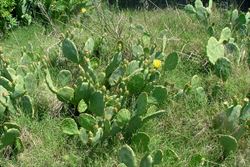
infestation (Photo: Sheldon Navie)
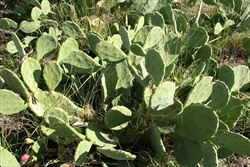
habit (Photo: Sheldon Navie)

habit of same plant following attack by biocontrol agents (Photo: Sheldon Navie)

stem segments (Photo: Sheldon Navie)

close-up of stem segment (Photo: Sheldon Navie)

young stem segment with tiny leaves (Photo: Sheldon Navie)
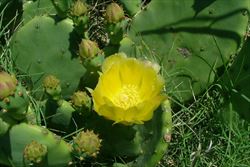
flower and flower buds (Photo: Sheldon Navie)

close-up of flower (Photo: Sheldon Navie)
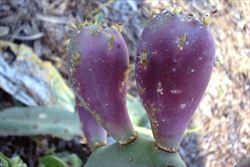
mature fruit (Photo: Sheldon Navie)

seedlings (Photo: Sheldon Navie)
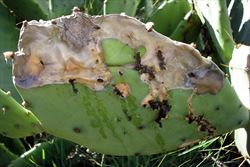
stem segment damaged by biocontrol agents (Photo: Sheldon Navie)
Scientific Name
Opuntia stricta (Haw.) Haw.
Synonyms
Opuntia bentonii GriffithsCactus opuntia var. inermis DC.Cactus strictus Haw.Opuntia inermis (DC.) DC.Opuntia stricta (Haw.) Haw. var. strictaOpuntia vulgaris Mill. (misapplied)
Family
Cactaceae
Common Names
Australian pest pear, coastal prickly pear, common pest pear, common prickly pear, erect prickly pear, pest prickly pear, prickly pear, sour prickly pear, southern spineless cactus
Origin
Native to southern USA (i.e. Alabama, Florida, Georgia, Louisiana, South Carolina, Virginia and Texas), Mexico, Central America, the Caribbean and tropical South America (i.e. Venezuela and Ecuador).
Naturalised Distribution
This species is widely distributed and common throughout the eastern parts of Australia and is also scattered throughout many other parts of the country. It is most abundant in central and southern Queensland and in northern New South Wales. Also present in some parts of Victoria, South Australia and Western Australia, and in other parts of New South Wales and Queensland.
Habitat
A common weed of semi-arid, sub-tropical, tropical and warmer temperate regions. It inhabits open woodlands, rangelands, grasslands, pastures, waterways, roadsides, railways lines, coastal environs, gardens, disturbed sites and waste areas.
Habit
An upright (i.e. erect) or spreading fleshy (i.e. succulent) shrub usually growing 50-100 cm tall, but occasionally reaching up to 2 m in height.
Distinguishing Features
- an upright or spreading fleshy shrub usually growing only 50-100 cm tall.
- its stems are much-branched and consist of a series of flattened fleshy segments.
- these stem segments are longer than they are broad and have groups of one or two sharp spines (2-4 cm long).
- its showy yellow flowers (6-8 cm across) are borne along the margins of the stem segments and the fleshy fruit turn reddish-purple in colour as they mature.
- its fruit (4-8 cm long and 3-4 cm wide) are egg-shaped and have several tufts of small barbed bristles on their surface.
Stems and Leaves
The stems are much-branched and consist of a series of flattened, fleshy (i.e. succulent), segments. These segments (10-35 cm long, 7-20 cm wide, and 10-20 mm thick) are green or bluish-green in colour and longer than they are broad (i.e. obovate in shape). They are hairless (i.e. glabrous) and covered in small raised structures (i.e. areoles) which bear tiny spiny bristles (i.e. glochids). These structures (i.e. areoles) either do not have any spines or may have one or two long sharp spines (2-4 cm long).
The leaves are reduced to tiny cylindrical (i.e. terete) or cone-shaped (i.e. conical) structures (4.5-6 mm long) and are quickly shed from the developing stem segments (i.e. they are caducous).
Flowers and Fruit
The flowers (up to 7 cm long and 6-8 cm across) are bright yellow, but often have pinkish or reddish coloured markings on the outer 'petals'. They are borne singly on fleshy bases along the margins of the stem segments. Each flower has large numbers of 'petals' (most of these are actually petal-like structures known as petaloids) and numerous stamens. Flowering occurs mostly during spring and summer.
The immature fruit are green in colour, but they turn reddish-purple as they mature. These berries (4-8 cm long and 2.5-4 cm wide) are fleshy (i.e. succulent), egg-shaped (i.e. obovoid), and usually have slightly depressed tips. Each fruit has several tufts of small barbed bristles (i.e. glochids) on its surface. The reddish or purplish coloured pulp in the centre of the fruit contains large numbers of seeds. These seeds (4-5 mm long and 4-4.5 mm wide) are generally yellow or pale brown in colour and somewhat rounded (i.e. sub-globular) in shape.
Reproduction and Dispersal
This plant reproduces by seed and also vegetatively via its fleshy (i.e. succulent) stem fragments (i.e. the stem segments may become dislodged and produce roots).
Stem fragments are spread by becoming attached to animals, footwear and vehicles. They may also be dispersed by floodwaters and in dumped garden waste. The fruit are eaten by various animals (e.g. birds and foxes) and the seeds then spread in their droppings.
Environmental Impact
Common prickly pear (Opuntia stricta) is regarded as an environmental weed in Queensland, New South Wales, Victoria and Western Australia. This species was recently listed as a priority environmental weed in two Natural Resource Management regions. It is also listed in the Global Invasive Species Database, and regarded to be in the top 100 of the world’s worst invasive alien species.
Legislation
This species is declared under legislation in the following states and territories:
- New South Wales: Class 4 - a locally controlled weed. The growth and spread of this species must be controlled according to the measures specified in a management plan published by the local control authority and the plant may not be sold, propagated or knowingly distributed (throughout the entire state). This declaration also applies to all prickly pears (i.e. Opuntia spp.), except Indian fig (i.e. Opuntia ficus-indica).
- Northern Territory: B - growth and spread of this species to be controlled (south of 18°S latitude, in areas outside of towns), and C - not to be introduced into the Territory. This declaration also applies to all prickly pears (i.e. Opuntia spp.).
- Queensland: Class 2 - landowners must take all reasonable steps to keep land free of this species (throughout the entire state). It is also illegal to sell a declared plant or its seed in this state. This declaration also applies to all prickly pears (i.e. Opuntia spp.), except Indian fig (i.e. Opuntia ficus-indica).
- South Australia: 1@ - this species is declared under Class 1c, a classification for prohibited terrestrial plants. It is declared, and its control is required, throughout the entire state. This declaration also applies to all prickly pears (i.e. Opuntia spp.), except Indian fig (i.e. Opuntia ficus-indica).
- Victoria: P3 - prohibited and must be eradicated or controlled (in the Mallee, West Gippsland and East Gippsland regions), and C3 - all reasonable steps must be taken to control the weed and prevent its spread (in the North Central, Port Phillip West and North East regions).
- Western Australia: P1 - the movement of this species or its seeds is prohibited (for all local authority areas in that part of the state north of the 26th parallel of latitude), P2 - to be eradicated (for all local authority areas in that part of the state north of the 26th parallel of latitude, except for the Exmouth, Carnarvon, Murchison, Upper Gascoyne and Shark Bay local authority areas), and P4 - it must be 'contained' (in the Exmouth, Carnarvon, Murchison, Upper Gascoyne and Shark Bay local authority areas). This declaration also applies to all prickly pears (i.e. Opuntia spp.).
Management
For information on the management of this species see the following resources:
- the Biosecurity Queensland Fact Sheet on prickly pear identification and control, which is available online at http://www.dpi.qld.gov.au.
- the Northern Territory Department of Natural Resources, Environment and The Arts Agnote on this species, which is available online at http://www.nt.gov.au/weeds.
- the Victorian Department of Primary Industries Landcare Note on this species, which are both available online at http://www.dpi.vic.gov.au.
Similar Species
Common prickly pear (Opuntia stricta) is very similar to spiny pest pear (Opuntia dillenii) and intermediates between the two species are sometimes seen in Australia. It is also similar to Indian fig (Opuntia ficus-indica), white-spined prickly pear (Opuntia streptacantha), drooping tree pear (Opuntia monacantha) and velvety tree pear (Opuntia tomentosa). These species can be distinguished by the following differences:
- common prickly pear (Opuntia stricta) is a low-growing plant (usually 50-100 cm tall) with relatively large flattened and elongated (i.e. elliptic or obovate) stem segments. These stem segments are hairless and generally do not have any spines (sometimes one or two large spines are present) on the small raised bumps (i.e. areoles) on their surfaces. The flowers are bright yellow and the fruit reddish-purple.
- spiny pest pear (Opuntia dillenii) is a low-growing plant (usually 50-100 cm tall) with relatively large flattened and elongated (i.e. elliptic or obovate) stem segments. These stem segments are hairless and have groups of 1-7 large spines on most of the small raised bumps (i.e. areoles) on their surfaces. The flowers are bright yellow and the fruit reddish-purple.
- Indian fig (Opuntia ficus-indica) is a relatively tall shrubby or tree-like plant (usually 1.5-3 m tall) with very large flattened and elongated (i.e. oblong, elliptic or obovate) stem segments. These stem segments are hairless and do not have any spines on the small raised bumps (i.e. areoles) on their surfaces. It has yellow flowers and reddish coloured fruit.
- white-spined prickly pear (Opuntia streptacantha) is a relatively tall and sometimes tree-like plant (usually 2-4 m tall) with flattened and egg-shaped (i.e. obovate) to almost circular (i.e. orbicular) stem segments. These stem segments are hairless and have groups of 3-20 small white spines on most of the small raised bumps (i.e. areoles) on their surfaces. It has yellow flowers and dull red or yellowish coloured fruit.
- drooping tree pear (Opuntia monacantha) is a relatively tall shrub or tree-like plant (usually 2-5 m tall) with flattened and elongated (i.e. oblong or obovate) stem segments. These stem segments are hairless and have one or two large spines on most of the small raised bumps (i.e. areoles) on their surfaces. It has yellow flowers and reddish-purple fruit, and some of its stem segments droop towards the ground during fruiting.
- velvety tree pear (Opuntia tomentosa) is a tall plant that is tree-like in appearance (up to 6 m tall) with flattened and elongated (i.e. oblong or elliptic) stem segments. These stem segments are velvety hairy (i.e. finely pubescent) and do not have any spines on the small raised bumps (i.e. areoles) on their surfaces. It has orange flowers and reddish-purple fruit.

